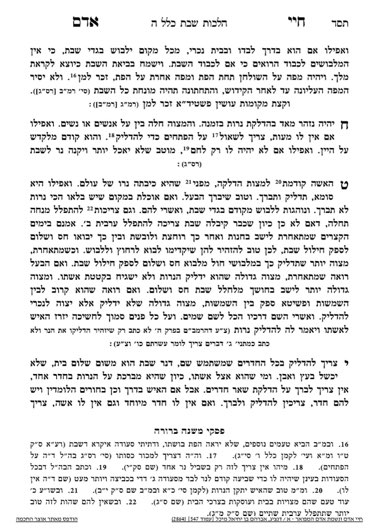We are continuing in siman 9. The Chayei Adam writes that a woman should be dressed for Shabbos when she lights Shabbos neiros. He will later qualify that it is more important to light on time than to wait until being fully dressed for Shabbos, as lighting too late is a question of an issur, while lighting when fully dressed for Shabbos is a question of a hiddur. It is a beautiful hiddur to be properly dressed for the mitzvah, but certainly not meakeiv the mitzvah.
The Chayei Adam continues, and writes that a woman should daven mincha before hadlakas neiros, because the act of hadlakas neiros is assumed to be an act of kabbalas Shabbos. The Chayei Adam is going with the approach that kabbalas Shabbos will be a conflict to mincha. Although we learned that kabbalas Shabbos is not arguably a conflict, we learned that the act of hadlakas neiros is an act of kabbalas Shabbos atzmah. We learned (S0121) that there are two types of kabbalas Shabbos, a kabbalah of tosefes Shabbos, which arguably would not be a contradiction to mincha, and a kabbalah of kedushas Shabbos atzmah, which is akin to reciting barechu (S0119), and after which point one can no longer daven mincha.
If a woman makes a tnai (stipulation) that she is not accepting kedushas Shabbos by lighting neiros, it works, but we will learn later that making a tnai is not so simple.
Therefore, the Chayei Adam writes that a woman should daven mincha before hadlakas neiros. The Piskei MIshnah Berurah point out that if a woman is running late, and has a choice between davening mincha and lighting, she should light and daven maariv twice as a tashlumin for mincha.
We need to understand this idea of davening maariv twice, and specifically how it relates to women. The Mishnah Berurah writes earlier, in hilchos tefillah, that a woman is chayav to recite shemoneh esrei both for shachris and mincha. A woman who is burdened by taking care of young children is exempt because she is an oneiss, but inherently, the chiyuv of shachris and mincha is the same for women as it is for men.
The Gemara says that originally, maariv was never a chiyuv, not even for men. However, men took it upon themselves as a chiyuv. Women never accepted that chiyuv. So how does this affect tashlumin? If a person misses a tefillah, they can recite two shemoneh esrei in the following tefillah, and the second shemoneh esrei is known as tashlumin for the tefillah missed. Tashlumin can only be done in conjunction with a tefillah which is an established tefillah, so if a woman misses mincha, which she is chayav in, she now davens maariv twice. In this instance, she will be required to daven Maariv in order to be able to daven tashlumin for Mincha.
Over here, we have another chiddush, which is that the tashlumin shemoneh esrei (shemoneh esrei for Friday night) is not the same shemoneh esrei as the tefillah missed (weekday mincha shemoneh esrei), yet it still allows her to fulfill her obligation. This is true both for men and for women.
Summary
- A woman should be fully dressed for Shabbos when lighting neiros; however, it is only a hiddur, so it should not come at the expense of lighting too late.
- A woman should daven mincha before hadlakas neiros. If she does not have enough time for both, she should light and perform tashlumin by davening Maariv and the maariv shemoneh esrei twice.



